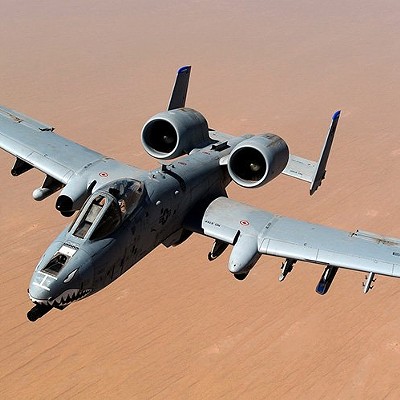The U.S. Air Force is in the process of selecting bases to handle the training and operational needs of the new F-35 Joint Strike Fighter. These decisions should be announced in the next several months and there's a chance that Davis-Monthan (DM) Air Force Base—having trained jet pilots for decades—will be considered.
Despite that, serious questions are being raised about whether the F-35 would be good for the community, since the plane is considerably louder than the A-10 that has been flying over Tucson for many years.
Hoping to see a continued infusion of federal dollars into the local economy, the DM-50, a volunteer group of local business leaders and concerned citizens who advocate for the base, in 2004 began pushing for the F-35 to come to town.
Over the past several months, though, instead of lobbying for the F-35, the DM-50 has been focusing on updating its vision statement.
"We're formulating a vision of what the community would like to see Davis-Monthan be in 25 to 30 years," says the group's president, Glen Kerslake.
"We're imagining ourselves in 2035, then looking back," he explains of the process. "That might include lobbying for the F-35," he adds.
Kerslake says the document should be completed in November and comments and support will then be solicited from the community.
Meanwhile, the original list of approximately 200 potential bases for the F-35 will be whittled down by the Air Force using criteria such as proximity to gunnery ranges, cost and environmental concerns.
The latter—specifically noise and urban encroachment around DM—are sticking points for inner city residents like Anne and Robin Gomez. They have been working for the past five years on a committee dedicated to balancing the needs of the base with those of the community.
"The F-35 will affect an area five to 10 times as large as the A-10," says Robin Gomez, who served four years in the U.S. Navy, and retired eventually from the Foreign Service. "We've been fighting for noise and safety issues, and are not opposed to the base at all."
The Gomezes have also been following the struggle in Valparaiso, Fla., over the F-35 ever since nearby Eglin Air Force base was selected as the initial operational site for the plane.
Using the Air Force's own decibel (dB) levels and tables, a group of retired engineers in Valparaiso quickly realized that this new mission, if carried out as planned, would render half their community unlivable by federal noise standards.
The F-35 produces noise in the 105 dB range during landings. Noise like that is just quieter than the sound a power mower produces three feet away from a listener and is also well above the level at which sustained exposure may result in hearing loss.
In a somewhat similar landing situation, by comparison, where every 10 dB accounts for a doubling of volume, the A-10 reportedly produces 90 dB of noise.
Valparaiso is suing the Air Force for not properly disclosing in its environmental impact study how the excessive noise of the F-35 would affect community residents. Yet speaking to Mayor John Arnold, there's no question how much he values the mission of the base.
"We'd be proud to be known as Fighter Town U.S.A.," says Arnold. "Our concern has always been how much the Air Force plan would harm Valparaiso. ... We're not trying to argue with the Air Force," he says, "but it's the noise that concerns us."
While officials in Phoenix are actively pushing for the F-35 to be sent to Luke Air Force Base, so far Tucson's elected leaders have said little about a possible F-35 mission at DM.
Ward 4 councilmember Shirley Scott represents many of the people who live off the southeast end of the DM runway and observes of her constituents, "The bulk of Ward 4 usually has a pro-base position, which is at variance with some others in the community."
Scott also comments of the F-35 process and lobbying, "When the Air Force makes a decision, it's based on their own criteria. They're happy to take input, but ultimately decide on their own specifics."
Kerslake shares that view. "There's no specific effort to bring the F-35 to DM," he says of the group he leads. "We're not actively lobbying for the F-35."
For her part, Anne Gomez is skeptical that Tucson will become a serious contender for the plane. "Due to (land use) encroachment issues," she says, "I can't imagine the Air Force would bring the F-35 to Tucson."
If that's the case, and with the A-10 due to be retired sometime in the next 20 years, what will the future of DM become? Are there quieter and less dangerous missions that could operate out of Davis-Monthan?
As Arnold in Florida says of working with the Air Force, "It's very important to never stop communicating."
No doubt a great deal of communication over the future of DM will surface—as it has in the past—when the DM-50 invites the public to comment on its vision plan.
Robin Gomez is happy to hear about that opportunity. "The update of the DM-50 (vision statement) is complete news to us," he says. "Maybe they are beginning to get the message."
From his perspective, Kerslake says about the DM-50, "We want to make sure our third largest employer stays here. That means taking into account (land use) encroachment and noise, but we don't want to lose DM."










